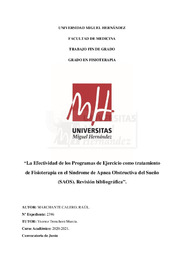Título :
La Efectividad de los Programas de Ejercicio como tratamiento de Fisioterapia en el Síndrome de Apnea Obstructiva del Sueño (SAOS). Revisión bibliográfica |
Autor :
Marchante Calero, Raúl |
Tutor:
Tronchoni Murcia, Vicente |
Editor :
Universidad Miguel Hernández de Elche |
Fecha de publicación:
2021-06-21 |
URI :
http://hdl.handle.net/11000/25602 |
Resumen :
Introducción: El síndrome de apnea obstructiva del sueño (SAOS) es un trastorno respiratorio crónico ocasionado por el colapso de las vías respiratorias superiores afectando entre un 9% y un 38% a la población adulta general. Aunque hay diversos tratamientos para el SAOS, siendo el dispositivo CPAP el más utilizado, también encontramos programas de ejercicio basados en la fisioterapia que pueden utilizarse como tratamiento.
Objetivo/s: Comprobar la efectividad de los diferentes programas de ejercicio sobre la gravedad y sintomatología del SAOS en pacientes adultos.
Material y Métodos: Se ha llevado a cabo una búsqueda bibliográfica en cuatro bases de datos, uniendo las palabras clave con los operadores booleanos AND y OR. Se filtró la búsqueda en cada base siguiendo los criterios de inclusión y exclusión, obteniendo un total de 21 estudios para su posterior análisis.
Resultados: el uso de ejercicio aeróbico y de resistencia reduce significativamente el índice de apnea-hipopnea (AHI) y la sintomatología del SAOS, la terapia miofuncional o ejercicios orofaríngeos también han mostrado su eficacia en la gravedad de la enfermedad, al igual que el entrenamiento muscular respiratorio que ha sido beneficioso en estos pacientes. Además, la combinación de todas estas terapias entre sí y en combinación con el CPAP tiene mejores resultados.
Conclusiones: Los diferentes programas de ejercicio físico, sobre todo el ejercicio aeróbico y de resistencia, tienen resultados prometedores sobre el SAOS, aunque se necesitan más estudios para dar mayor claridad sobre su eficacia.
Introduction: Obstructive sleep apnea syndrome (OSAS) is a chronic respiratory disorder caused by upper airway collapse affecting between 9% and 38% of the general adult population. Although there are various treatments for OSAS, with the CPAP device being the most commonly used, there are also physiotherapy-based exercise programmes that can be used as a treatment.
Objective(s): To test the effectiveness of different exercise programmes on the severity and symptomatology of OSAS in adult patients.
Material and Methods: A literature search was carried out in four databases, linking keywords with the Boolean operators AND and OR. The search was filtered in each database following the inclusion and exclusion criteria, obtaining a total of 21 studies for subsequent analysis.
Results: the use of aerobic and resistance exercise significantly reduces the apnoea-hypopnoea index (AHI) and the symptomatology of OSAS, myofunctional therapy or oropharyngeal exercises have also been shown to be effective in the severity of the disease, as has respiratory muscle training which has been beneficial in these patients. Furthermore, the combination of all these therapies with each other and in combination with CPAP, has better results.
Conclusions: Different physical exercise programmes, especially aerobic and resistance exercise, have promising results on OSAS, although further studies are needed to give more clarity on their efficacy.
|
Palabras clave/Materias:
Exercise
Myofunctional therapy
physical therapy modalities
Sleep Apnea Obstructive |
Área de conocimiento :
CDU: Ciencias aplicadas |
Tipo documento :
application/pdf |
Derechos de acceso:
info:eu-repo/semantics/openAccess |
Aparece en las colecciones:
TFG - Fisioterapia
|
 La licencia se describe como: Atribución-NonComercial-NoDerivada 4.0 Internacional.
La licencia se describe como: Atribución-NonComercial-NoDerivada 4.0 Internacional.
.png)
